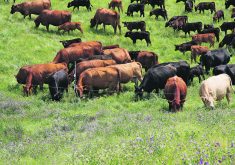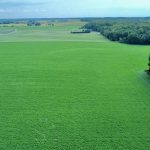Gravel vs. water
The Western Producer could well print more articles along the lines of Joe Obad’s April 15 article on watershed protection and Brenda Kossowan’s April 22 article on gravel pits threatening water resources.All life, and certainly agriculture, depends on water, which is being wasted and polluted at alarming rates.Gravel mining has already caused extensive damage to Canadian watersheds, and in Alberta at least, this situation is about to get much worse if all levels of government do not wake up immediately. We all depend on gravel to varying degrees, but not to the extent that we depend on water, so watershed health cannot continue to be sacrificed to gravel mining.Permanent loss of arable land is another result of poor planning and gravel excavation from ground water aquifers. Where huge holes are dug below the water table, the land often cannot be reclaimed. End-pit lakes remain, exposing ground water to contamination and evaporation, and productive land is lost forever.Federal, provincial and municipal governments and aggregate developers all have a responsibility to begin immediately planning for more responsible gravel mining, which will not excavate into any water bodies of any description.Donna Mendelsohn,Fort Assiniboine, Alta.
Read Also

Forecast leans toward cooling trend
July saw below average temperatures, August came in with near to slightly above average temperatures and September built on this warming trend with well above average temperatures for the month.
Farmers should decide
Unlike Rolf Penner (“It’s time to give farmers a real choice”, May 6), we at the Canadian Wheat Board believe that farmers themselves should decide the fate of their marketing organization, not the federal government.While Mr. Penner makes much of a recent Supreme Court ruling, he has missed the most crucial point of all: that western Canadian farmers have the right to control of the CWB, as intended by 1998 amendments to the CWB Act. That is the principle we will continue to fight to uphold.Farmers elect their representatives on the CWB board of directors. In 2008, the farmers of southern Manitoba elected me over a slate of opposing candidates, which included Mr. Penner. I believe that gives me some authority to speak on their behalf.In fact, there are 10 farmers on the CWB board, eight of us elected on a clear platform of support for the CWB single-desk marketing structure. We interpret our election as an indication of support for this mandate. That is democracy. What Mr. Penner proposes is not. Instead, he calls for the democratic will of farmers to be ignored.To support his position, he has made selective use of the facts. For example, a 2007 federal “plebiscite” among barley farmers actually showed that only 14 percent wanted an open market for barley, which is exactly what they would get without the single desk. It provided no authority for dismantling the CWB, particularly since the concept of a “voluntary CWB” or “dual market” is pure fiction.In addition, last year’s CWB producer survey showed that 63 percent of farmers support the single desk for wheat, when asked to make a realistic choice between that or an open market. On barley, they were fairly evenly split.Mr. Penner may not agree with my position on the value of the CWB for farmers. But he cannot claim that he speaks for them. And he should think twice before encouraging the government to force fundamental grain-marketing changes they have not approved.Bill Toews,CWB director,
Farmland hazard
I recently read in The Western Producer (Open Forum, May 6) that oak access mats carry a high risk of being infected with an aggressive fungal pathogen similar to clubroot. I have now learned that AltaLink uses oak access mats, and plans to continue to use oak access mats, even though they are aware of the environmental risks. The costs and long-term damage of such risks is left to the landowner, who likely won’t discover this contamination until AltaLink is long gone. Good luck proving it wasn’t your fault. To compound matters, an engineer from AltaLink was heard to say that AltaLink does not, and will not, clean or pressure wash the mats before they are transported to another location.If true, this violates current environmental safety practices.The practice of using oak access mats contradicts AltaLink’s statements that they are environmentally responsible. The fact that AltaLink claims that they do not clean the mats before transporting the mats to another location is absolutely irresponsible. AltaLink needs to respond to these allegations satisfactorily, and explain why they are not using locally produced native wood access mats, such as lodgepole pine.Landowners and farmers need to demand that industry, particularly AltaLink, use locally produced pine access mats. Furthermore, people need to demand that all mats be properly sanitized before they are transported.N. Donna Wise,Rockyford, Alta.
Live by the sword
In the Canadian Wheat Board’s recent ad campaign regarding the latest World Trade Organization draft proposal, the CWB argues that prairie farmers will have no say on how Canada’s grain marketing system will be structured. They say that other countries will “call the shots.”Good. Now the CWB knows exactly how I feel when they call the shots on the marketing decisions on my farm.If a majority of other countries decide that Canada should not have a single desk in wheat and barley marketing, then the CWB should step aside and simply abide by the wishes of the majority. After all, that’s exactly how they treat the prairie farmer.If the CWB wants to live by the sword, it must die by the sword. How can they argue that the wishes of one individual country must be respected at the WTO when they show absolutely no such respect to individual farmers on the Prairies?Every country can opt out of the WTO if it so wishes as it’s a voluntary agreement. Likewise, every farmer should have the opportunity to opt out of the CWB. Con Johnson,Bracken, Sask.
Milk and trade
I would like to comment on your article, “Canada hesitates to join Pacific Rim trade talks” (WP, April 29.)If we have refused to join Pacific Rim free trade talks, it shows the (federal) government has considered our supply management sector of our agriculture. If we put our dairy supply management on the table, it would be disastrous to our dairy industry. My wife and I lived in New Zealand for eight years of which we share- milked for five years and this is what the Canadian dairy farmer would have to compete with. We managed a 120 acre farm in Taranaki, North Island. We milked 135 Jersey cows and were completely self-sufficient. We grew all our hay, all our silage and our grass grew 12 months of the year. We had a double-four, walk through milk parlour in a three-sided roofed shed and an attached milk tank house, a hay barn, fertilizer shed and a machinery lean-to. Our machinery was a Massey 135, half-ton fertilizer spinner, chain harrows, silage chopper and cage. The chopper was side mounted and the cage fit on the back of the tractor. The back of the cage was a swinging gate, making it a one man/woman operation. No feed of any kind was purchased. The main input purchase was fertilizer, which was applied twice a year at 500 pounds per application. Compare this with Canadian winter barns and milk parlours and our huge grain inputs costing thousands a week. Then there is alfalfa hay purchases. Canadian input costs per litre of milk are going to be two or three times that of New Zealand. What chance do our dairy farmers have competing with New Zealand dairy farmers or Australian dairy farms?I believe Canadian dairy farmers can compete with any dairy farmers anywhere as long as there is a level playing field. In these trade talks, the field is not level.Mervyn Coles,Nelson, B.C.














